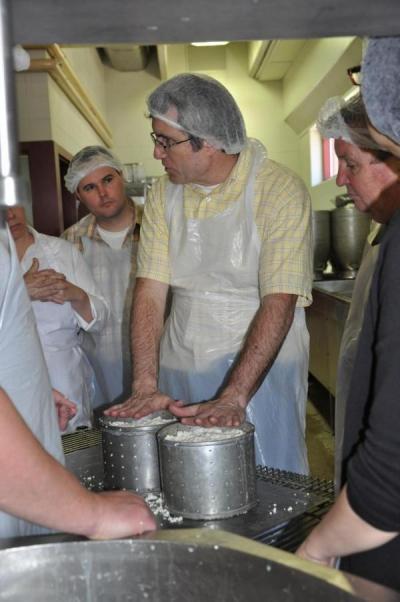Arthur Hill

Find Related People by Keyword
Professor
Art completed a BSc in Agr (spec Dairy Science) and both MSc and PhD in Food Science at Guelph and joined the faculty at Guelph in 1986. Art has served in various administrative and leadership roles on campus, including President of the University of Guelph Faculty Association. Art was promoted to full professor in 2007, and appointed Chair Department of Food Science in 2009. Art’s research relates to dairy science and technology, especially cheese science, including cheese safety. Art has taught a variety of food related subjects including technical communication and has been heavily involved with external training including the Maple Leaf Food Safety Foundation and short courses in cheese science and technology. Administrative achievements/activities include establishment of external revenues in support of the Department’s core missions (teaching, research, outreach), development of the Guelph Food Innovation Centre, and the Guelph Food Academy. Current projects are creation of a Food Formulation laboratory and renovation of the Food Processing Pilot Plants.
Academic History
Affiliations and Partnerships

Research
A major theme is cheesemaking properties of milk as related to processing treatments and interactions among milk proteins and nutritionally functional ingredients. (1) Our group demonstrated the efficacy of using milk naturally (via dairy cow rations) supplemented with omega-3 fatty acids for dairy processing, including ripened cheese. (2) At a time when many papers and patents extolled the utility of ultrafiltered milk for cheese making, we demonstrated that even low concentration by UF had substantial impacts on cheese making properties and recommended means to mediate those impacts. (3) Recombined cream composed of partially denatured whey proteins and butter was engineered to obtain fat globule size distribution similar to native cream. Unlike casein coated fat globules in homogenized milk, the whey protein stabilized fat globules did not interact with caseins during rennet coagulation and could be used to make good quality cheese. It was demonstrated that Vit D and Omega-3 fats can be incorporated into the whey stabilized creams with minimal loss during Cheddar cheese making and ripening up to six months. The practical outcomes are that it is now feasible to make quality cheese from skimmed milk powder or milk protein concentrates, and butter or butter oil, and further, it is now possible to add fat soluble nutrients to cheese without carriers other than the natural milk components.
Another current research area is preventative control programs in cheese making including cheese maker awareness and definition of critical control points optimized for technological families of cheese. This work currently in progress is quite important for artisan cheese makers, but larger cheese makers also struggle to optimize CCPs for Cheese HACCP programs.
Several earlier projects relate to milk pricing and composition analysis. (1) Equitable milk pricing: An algorithm, developed to convert w/w milk composition values to w/v is now used for farm gate milk pricing has been used nationally since 2004, making Canada, as far as we can determine, the only jurisdiction in the world that accurately accounts for milk density in milk pricing. (2) Bulk milk tank mixing time. In spite of much research there was no scientific basis for any of many national and international protocols for pre-mixing bulk tanks before sampling for compositional analysis. Our innovative approach allowed conclusive definition of mixing times required to ensure homogenous samples, solving a 60-year dilemma in the industry. (3) Casein in Ontario milk: a simple algorithm was developed to predict casein from total milk protein. The algorithm is still used by cheese makers who cannot access the newer mid-infra red milk analyzers.
Featured Publications
Boldyreva*, E. M., Hill, A. R., Griffiths, M., & Marcone, M. (2016). The quality and safety of washed-rind cheeses with a focus on antilisterial protection. International Dairy Journal 55:26 – 37.
Kethireddipalli, P. & Hill, A. (2015). Rennet coagulation and cheesemaking properties of thermally processed milk: Overview and recent developments. Journal of Agricultural and Food Chemistry 63 (43):9389–9403
Le, S., Bazger, w., Hill, A., & Wilcock, A. (2014). Awareness and perceptions of food safety of artisan cheese makers in Southwestern Ontario: A qualitative study. Food Control, 41 (01), 1-10.
Zhang, W., Kakuda, Y., & Hill, A. (2006). Conjugated linoleic acid (CLA) in processed cheese. Milchwissenschaft (62), 174-178.
Servello, V., Hill, A., & Lencki, R. W. (2004). Towards an optimum mixing protocol for on-farm bulk milk sampling. Journal of Dairy Science, 87 (9), 2846-53.
Avramis, C. A., Wang, H., McBride, B. W., Wright, T. C., & Hill, A. (2003). Physical and processing properties of milk, butter and Cheddar cheese from cows fed supplemental fish meal. Journal of Dairy Science, 86 (8), 2568-76.